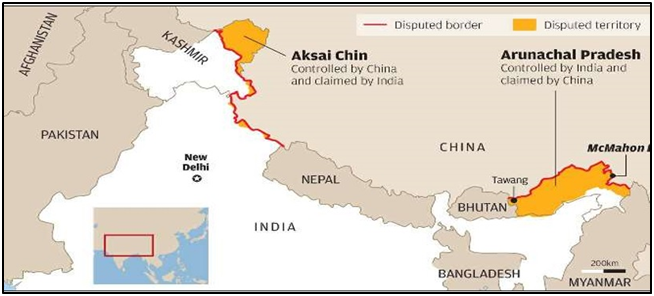- Courses
- GS Full Course 1 Year
- GS Full Course 2 Year
- GS Full Course 3 Year
- GS Full Course Till Selection
- Answer Alpha: Mains 2025 Mentorship
- MEP (Mains Enrichment Programme) Data, Facts
- Essay Target – 150+ Marks
- Online Program
- GS Recorded Course
- Polity
- Geography
- Economy
- Ancient, Medieval and Art & Culture AMAC
- Modern India, Post Independence & World History
- Environment
- Governance
- Science & Technology
- International Relations and Internal Security
- Disaster Management
- Ethics
- NCERT Current Affairs
- Indian Society and Social Issue
- NCERT- Science and Technology
- NCERT - Geography
- NCERT - Ancient History
- NCERT- World History
- NCERT Modern History
- CSAT
- 5 LAYERED ARJUNA Mentorship
- Public Administration Optional
- ABOUT US
- OUR TOPPERS
- TEST SERIES
- FREE STUDY MATERIAL
- VIDEOS
- CONTACT US
INDIA REJECTED CHINA RENAMING PLACES IN ARUNACHAL PRADESH
INDIA REJECTED CHINA RENAMING PLACES IN ARUNACHAL PRADESH
05-04-2024
News Highlights:
- India strongly rejected the renaming of places in Arunachal Pradesh by China and said that keeping the names will not change the fact that the state is, has been, and will always be an integral and inalienable part of India.
- The move comes after China announced the names of 30 more places in Arunachal Pradesh, which it claims to be Southern Tibet.
Key Points:
Border Dispute in the Eastern Sector:
- The disputed border in the eastern sector of the India-China border revolves around the McMahon Line.
- Representatives of China, India and Tibet met in Shimla in 1913–14 to decide the Tibet–India and Tibet–China boundaries.
- Sir Henry McMahon, then Foreign Secretary of British India, drew the 550-mile (890 km) McMahon Line as the boundary between British India and Tibet during the Simla Conference.
Border Dispute in Eastern Sector of LAC

The McMahon Line Dispute:
- The McMahon Line largely shifted British control northward, ceding Tawang and other Tibetan areas to the British Empire.
- Although Chinese representatives initially approved the agreement, they later refused to accept it.
- China has rejected the McMahon Line as "illegal" and accused India of occupying areas of Arunachal, which it considers part of southern Tibet.
China's Claims and Historical Ties:
- China claims territory in Arunachal Pradesh, south of the McMahon Line.
- It claims based on historical ties between the monasteries in Tawang and Lhasa.
Arunachal Pradesh and the 1962 Indo-China War:
- Arunachal Pradesh, disputed by China, is spread over approximately 90,000 sq km and is the largest disputed area.
- The People's Liberation Army captured the area during the 1962 war, but later withdrew respecting the McMahon Line.
- However, China continues to assert its claim to this area.

Renaming of Places by China:
- In recent years, the Ministry of Civil Affairs of China has issued a list of standardized geographical names in Arunachal Pradesh.
- The first batch of six names was released in 2017, followed by 15 in 2021, 11 in April 2023 and 30 in March 2024.
China's Territorial Claims and Strategy:
- China claims about 90,000 sq km of Arunachal Pradesh and refers to it as Zangnan.
- In Chinese maps, Arunachal Pradesh is shown as part of China.
- Changing the name and territorial claims are part of China's strategy to assert its sovereignty over Indian territory.
- It regularly issues statements of outrage when Indian dignitaries visit Arunachal Pradesh.
China's Justification and Historical Claims:
- Chinese officials claim that standardization of names is necessary in southern Tibet because minority ethnic groups have passed them down orally from generation to generation.
- China claims its sovereignty on historical, cultural, administrative and judicial grounds.
FAQs:
Q. What is the Simla Convention?
Ans. The Simla Convention, officially the Convention Between Great Britain, China, and Tibet, was an ambiguous unequal treaty concerning the status of Tibet negotiated by representatives of the Republic of China, Tibet and Great Britain in Simla in 1913 and 1914.
Q. When did China gain control of Aksai Chin ?
Ans. India and China have had a border dispute since the 1962 Sino-Indian War, which resulted in China gaining control of Aksai Chin. The two countries have made efforts to resolve the issue, but disagreements persist, particularly in areas like Arunachal Pradesh.
Must Check: Best IAS Coaching In Delhi



